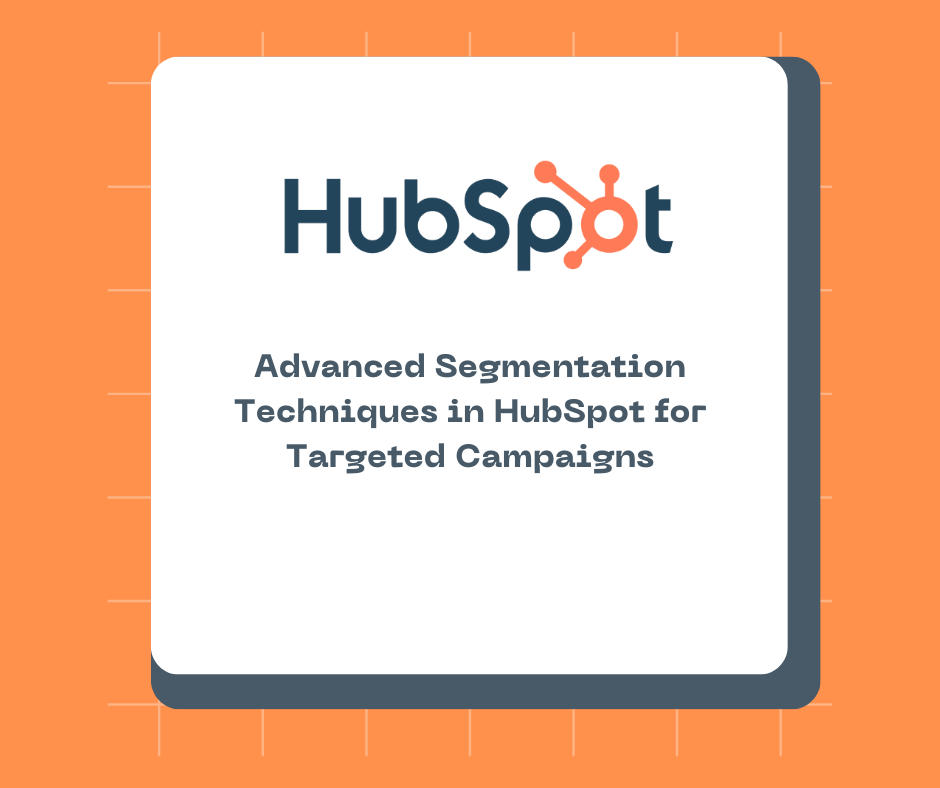In the dynamic world of marketing, personalization has become the cornerstone of successful campaigns. Gone are the days of generic messaging; today's consumers expect tailored experiences that resonate with their individual needs and preferences. Advanced segmentation techniques play a crucial role in achieving this level of personalization, allowing marketers to divide their audience into distinct groups based on specific criteria. With HubSpot's powerful segmentation capabilities, marketers can take their campaigns to the next level by delivering targeted messaging that drives engagement and conversions. In this article, we'll explore advanced segmentation techniques in HubSpot and how they can be leveraged to create highly targeted campaigns that resonate with your audience.
Understanding Segmentation in HubSpot
Segmentation in HubSpot involves dividing your audience into groups based on shared characteristics or behaviors. HubSpot offers a variety of segmentation criteria, including demographic information, contact properties, engagement history, and more. By segmenting your audience, you can deliver personalized messaging and content that speaks directly to the needs and interests of each group.
Advanced Segmentation Techniques
1. Behavioral Segmentation
Behavioral segmentation involves dividing your audience based on their interactions with your brand, such as website visits, email opens, and content downloads. HubSpot allows you to create custom behavioral-based lists that target individuals who have taken specific actions or engaged with specific content. By targeting users based on their behavior, you can deliver highly relevant messaging that reflects their interests and stage in the buyer's journey.
2. Lifecycle Stage Segmentation
Lifecycle stage segmentation involves categorizing your audience based on where they are in the customer lifecycle, such as leads, customers, or advocates. HubSpot's lifecycle stage property automatically updates based on a contact's interactions with your brand, allowing you to target individuals with messaging that aligns with their current stage. For example, you can send educational content to leads or exclusive offers to existing customers.
3. Custom Property Segmentation
Custom property segmentation involves creating custom properties in HubSpot to capture additional information about your contacts, such as industry, job title, or purchase history. You can then use these custom properties to create highly targeted segments that reflect the unique characteristics of your audience. For example, you can create segments based on industry-specific interests or past purchase behavior.
4. Smart Lists
Smart lists in HubSpot are dynamic lists that automatically update based on predefined criteria. You can create smart lists using a combination of segmentation criteria, such as contact properties, behavior, and engagement history. Smart lists allow you to create highly targeted segments that adapt and evolve over time, ensuring that your messaging remains relevant and timely.
Implementing Advanced Segmentation in HubSpot
1. Define Your Segmentation Criteria
Before creating segments in HubSpot, it's essential to define your segmentation criteria based on your campaign objectives and target audience. Consider factors such as demographics, behavior, lifecycle stage, and custom properties that are relevant to your campaign goals.
2. Create Custom Properties
If you require additional information about your contacts that is not captured by default in HubSpot, you can create custom properties to store this data. Custom properties allow you to capture and segment contacts based on specific attributes that are unique to your business or industry.
3. Build Segments
Once you have defined your segmentation criteria and created any necessary custom properties, you can begin building segments in HubSpot. Use the segmentation tool to create lists based on your predefined criteria, taking advantage of HubSpot's advanced filtering options to create highly targeted segments.
4. Test and Refine
After creating your segments, it's essential to test and refine your targeting to ensure that your messaging resonates with your audience. Use A/B testing to experiment with different messaging and content for each segment, and use HubSpot's analytics tools to track performance and make data-driven decisions.
Benefits of Advanced Segmentation in HubSpot
Advanced segmentation in HubSpot offers several benefits for marketers looking to create targeted campaigns:
-
Improved Personalization: By segmenting your audience based on specific criteria, you can deliver personalized messaging and content that resonates with each group.
-
Higher Engagement Rates: Targeted campaigns are more likely to capture the attention of your audience and drive engagement, leading to higher conversion rates and ROI.
-
Enhanced Customer Experience: By delivering relevant and timely messaging, you can create a positive experience for your audience and build stronger relationships with your customers.
-
Better Campaign Performance: Targeted campaigns are more effective at driving results, whether it's increasing sales, generating leads, or driving website traffic.
Conclusion
Advanced segmentation techniques in HubSpot empower marketers to create highly targeted campaigns that resonate with their audience. By dividing your audience based on specific criteria such as behavior, lifecycle stage, and custom properties, you can deliver personalized messaging and content that drives engagement and conversions. Whether you're targeting leads, customers, or advocates, advanced segmentation in HubSpot offers the flexibility and scalability you need to create campaigns that deliver results. Embrace the power of advanced segmentation in HubSpot and take your campaigns to the next level of effectiveness and impact.
Schedule your training session here and comment “Need Training” on the request form.

Comments